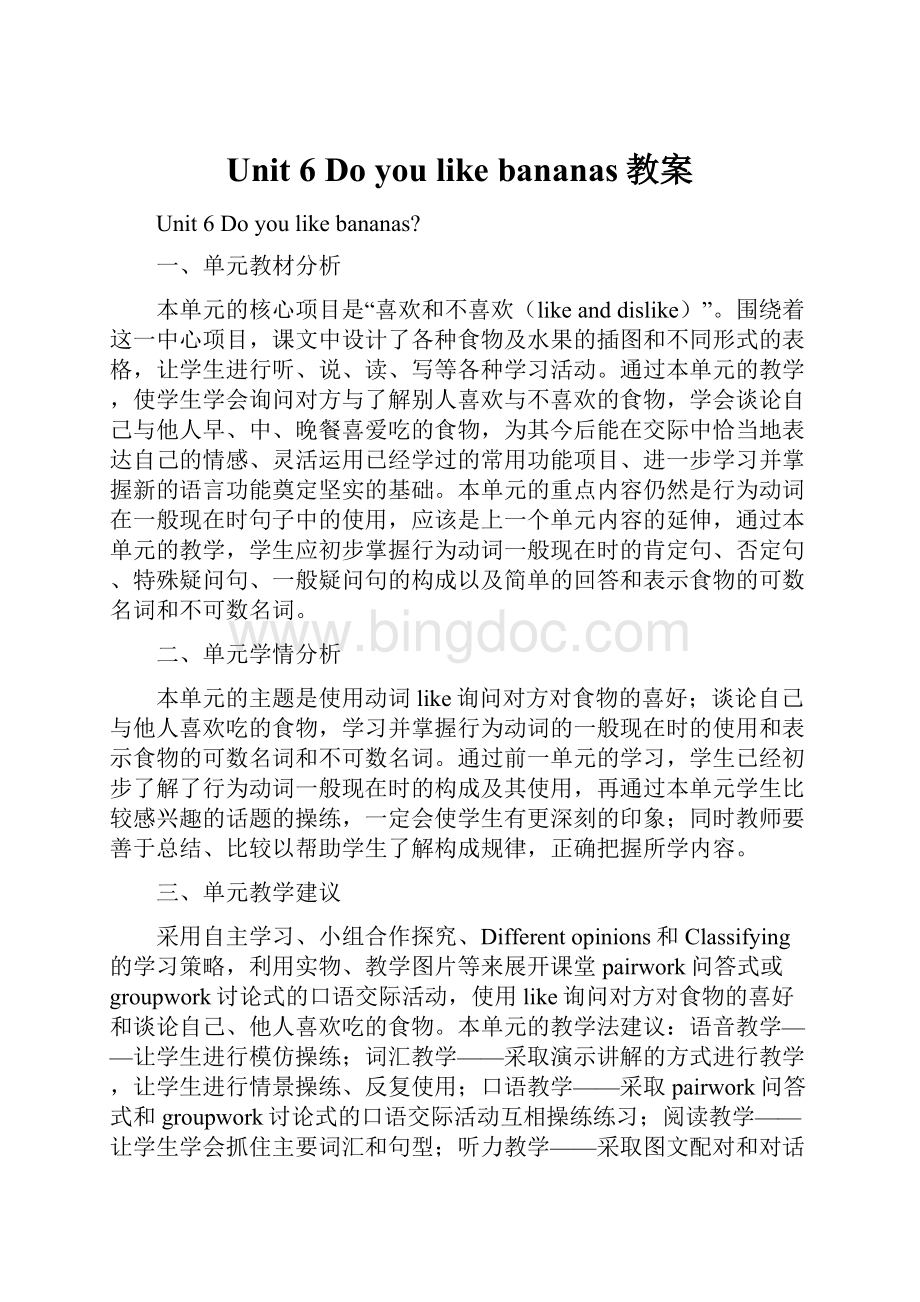Unit 6 Do you like bananas教案Word文档下载推荐.docx
《Unit 6 Do you like bananas教案Word文档下载推荐.docx》由会员分享,可在线阅读,更多相关《Unit 6 Do you like bananas教案Word文档下载推荐.docx(35页珍藏版)》请在冰点文库上搜索。

2)能掌握以下句型:
①—Doyoulikesalad?
—Yes,Ido./No,Idon’t.
②—Doesshe/helike…?
—Yes,she/hedoes./No,she/hedoesn’t.
③—Ilike…/Idon’tlike…
④—He/Shelikes…/He/Shedoesn’tlike…
3)能通过介绍食物学会询问对方喜欢与不喜欢的食物。
2.情感态度价值观目标:
该部分学习内容贴近学生的生活,谈论的主题涉及学生的饮食习惯和偏爱,对学生养成健康的饮食习惯很有帮助,能引起学生的特别关注,极易于激发学生学习英语的欲望和兴趣,使他们乐于参与各种英语实践活动。
通过学习西方食品文化,促使学生了解西方生活方式与文化,培养跨文化交际的意识。
二、教学重难点
1.教学重点:
1)学习并积累一些食物的词汇。
2)名词复数的使用。
3)动词like一般现在时的各种句式及一般疑问句的肯定、否定回答;
2.教学难点:
1)行为动词like的一般现在时的用法;
2)使用do和does引导的一般疑问句的构成和使用。
三、教学过程
I.Newwords
Accordingthepictures,learnthenewwords.
II.Warming-up
AsksomeSsquestions:
T:
What’sthat?
S1:
It’s_______.
WhatarethoseinEnglish?
Theyare_______.
III.Presentation
1.Showsomepicturesoffoodonthescreenandlearnthenewwords.
(banana,hamburger,tomato,ice-cream,salad,strawberry,pear,milk,bread,birthday,food,burger,vegetable,fruit)
2.LetSsreadandtrytorememberthenewwords.
3.T:
Let’slookatthepicturein1a.Matchthewordswiththethingsinthepicture.Thenchecktheanswers.
IV.Listening
T:
Let’sworkon1b.Listenandnumbertheconversations[1-3].
A:
Doyoulikesalad?
B:
No,Idon’t.
Doyoulikebananas?
Yes,Ido.
Doyoulikeoranges?
Sslistentothetapeandnumbertheconversations.
V.Pairwork
1.Readtheconversationsin1b.LetSsreadaftertheteacher.
2.Nowlet’sactouttheconversations1-3.
(Ssworkwiththeirpartnerandactouttheconversation1-3.)
3.Lookatthepictureandmakemoreconversationsusingthewordsin1a.
4.Letsomepairsactouttheirconversations.
VI.Listening
1.Pointtoandreadeachwordaloud,Ssonlylisten.ThenletsomeSsreadthewordsbythemselves.CheckthatSsunderstandthemeaningoftheeachword.
2.Playtherecordingforthefirsttime,Ssonlylisten.
3.ThenplaytherecordingagainSscirclethewordstheyhear.Playtherecordingagain.Checktheanswers.
hamburgerspearstomatoesstrawberries
orangesice-creamsaladbananas
4.Agirlandaboywanttohavesomethingintherestaurant.Dotheylikehamburgers?
Doestheboylikemilk?
Doestheboylikeice-cream?
Nowlet’slistentotherecording.
Forthefirsttime,Ssonlylisten.
5.Forthesecondtime,Sslistenandfillintheblanks.
—Ilikehamburgers.Doyoulikehamburgers?
—Yes,Ido.
—Doyoulike__________?
—No,Idon’tlike___________.
—Let’shave_________.
—Oh,no.
—No?
—Idon’tlike__________.
6.Playtherecordingforthethirdtime,Checktheanswers.
VII.Pairwork
1.Readtheconversationinspeechbubblesin2b.AskSstoreadaftertheteacher.
2.Sspracticetheconversationsinpairs.
3.Letsomepairsactouttheconversations.
4.Ssgiveanswersthataretrueforthem.Thenpracticetheirconversations.
5.Asksomepairsactouttheirconversations.
VIII.Reading
1.Readthedialoguein2d.Thenanswerthequestions.
DoesJohnlikehamburgers?
WhatdoesJackdon’tlike?
WhatfruitdoesJohnlike?
2.Finishthedialoguewithyourpartner.Thenroleplaytheconversation.
3.Practicetheconversationwithyourpartner.
4.评价:
(让学生们对自己的表现及语言表达能力进行自我评价,在小组内评价,然后进行评出最优秀的小组。
并鼓励学生们下一次争取做最优秀的小组及个人。
)
IX.Languagepoints
1.tomatoes西红柿tomatoes是tomato的复数形式。
e.g.Mysisterlikestomatoesverymuch.
我姐姐很喜欢吃西红柿。
拓展:
以字母o结尾的有生命词,其复数形式在词尾加-es。
2.John’sbirthdaydinnerisnextweek.
1)dinnern.(中午或晚上吃的)正餐
dinner指一日中的主餐,可中午吃,也可晚间吃。
但多用于指宴请客人的正式的一餐。
e.g.It’stimefor______.该吃晚饭了。
短语拓展
dinnerparty宴会
dinnertable餐桌
dinnertime吃饭时间
2)weekn.周;
星期
e.g.Sundayisthefirstdayofthe_____.星期日是一周的第一天。
短语集锦
lastweek上周
thisweek本周
nextweek下周
3.Let’sthinkaboutthefood.
thinkabout思考,思索
(一般是短时间的较仔细的考虑)
e.g.Whatdoyou___________that?
你认为怎么样?
I’llhaveto____________it.我得想一想。
thinkof想到;
想象;
设想多用来指“想起,认为”。
e.g.Icouldn’t_______thenameofthatmananyhow.
我怎么也想不出那人的名字来了。
Let’s________somequestionsaboutlife.
让我们对生活设想一些问题吧。
4.Sure.Howaboutburgers,vegetablesalad…?
sureadv.(用作副词)当然;
肯定;
一定常用来回答一般疑问句,意为“当然;
的确”,相当于yes或certainly。
只是sure在英国英语中较为常用,而在美国英语中常用certainly。
e.g.—Areyougoingwithus?
你和我们一起去吗?
—______.当然啦。
Howabout相当于Whatabout…?
意为“……怎么样?
”是一个用来征询别人的意见、向别人提建议的交际用语。
about是介词,后跟名词、代词或动词-ing形式。
e.g.Howaboutmeetingatnineo’clock?
9点钟怎么样?
Whatabouthavinghamburgers?
吃汉堡包怎么样?
【拓展】
英语中表示提建议的句型还有:
①Let’s...意为“让我们……吧”。
如:
Let’shavesomebananas.
②Whynot...?
意为“为何不……呢?
”。
Whynotaskourteacher?
vegetablesalad
vegetable在这里作定语,名词作定语,通常用单数形式,只有sports和clothes
例外。
5.Let’shavestrawberriesandapplesthen.
Let’shave…是一个祈使句,表示“让我们吃/喝……吧。
”
e.g.Let’shavesomeice-cream.让我们吃些冰激凌吧。
[归纳]have是多义词,归纳如下:
(1)有,拥有;
Ihaveanewwatch.我有块新手表。
(2)吃,喝;
Let’shavesomemilkandsomebread.
让我们喝些牛奶,吃些面包。
(3)构成固定短语:
havealook看一看
thenadv.那么
e.g.Whatshallwedo_____?
Swim?
那么我们该干什么呢?
游泳吗?
X.Exercises
Ⅰ.根据句意及所给图片提示,写出句中所缺单词。
1.Kate,thesethree_________arenotforyou.
2.Mom,Iwanttoeattwo_________.
3.Oh,no!
Idon'
tlike_________,Emma.
4.Jackie,canyougetfive_________forme?
5.Jeffcanseesome_________inthebag.
Ⅱ.根据语境及括号内所给单词的提示填空。
1.Alan,thosearenot_________(tomato).
2.Hey,Mary!
Letmegetsome_________(salad)foryou.
3.Isthe_________(milk)inthecupforme,Mom?
4.Wow,these_________(strawberry)areniceandIlovethem.
5.—What'
sitinEnglish?
—It'
san_________(orange).
XI.Homework
1.复习记忆本课所学的生词。
2.做个小调查,编写四个问答句:
分别询问一下你的家庭成员所喜欢的食物?
—Doyoulike…?
—Yes,Ido./No,Idon’t.
SectionA2(Grammarfocus-3c)
1)继续学习描述自己或他人喜欢或不喜欢的食物,能够用but来表达简单的句子。
2)总结动词like一般现在时的肯定句式、否定句式及一般疑问句的肯定、否定回答。
3)总结复习可数名词复数的知识。
4)理解英语可数名词与不可数名词的概念,并对所学过的部分词汇按此分类进行归纳总结。
通过任务型活动,使学生学会在实际生活中均衡饮食,合理配餐;
通过开展小组活动,指导学生积极与他人合作,培养他们的合作精神。
1)总结动词like一般现在时的肯定句式、否定句式及一般疑问句的肯定、否定回答。
2)理解英语可数名词与不可数名词的概念,并对所学过的部分词汇按此分类进行归纳总结。
理解英语可数名词与不可数名词的概念,并对所学过的部分词汇按此分类进行归纳总结。
I.Warmup
1.Ssmaylookatsomepicturesandpracticethedialoguesandsentences.
Doyoulike_________?
Yes,____.
No,________.
___you_______________?
___they__________?
No,__________.
Ilike____________.
I_______________.
He____________.
He______________________.
She_________________.
2.SscompletethesentencesfromGrammarFocus.
1)你喜欢色拉吗?
____you____salad?
2)是的。
____,I____.
不,不喜欢。
_____,I______.
3)他们喜欢梨吗?
_________likepears?
4)是的。
____,they____.
___,they______.
5)她喜欢西红柿吗?
_____she_____tomatoes?
6)是的。
____,she_____.
____,she________.
7)我喜欢桔子。
我不喜欢香蕉。
I___________.I_________bananas.
8)我们喜欢米饭。
我们不喜欢汉堡。
We________.We________hamburgers.
9)他喜欢冰淇淋。
他不喜欢蔬菜。
He_____ice-cream.
He____________vegetables.
II.like的用法
动词like意为“喜欢”。
我们可以用like来谈论对物的喜好。
◆形式
①当主语是第一、二人称单复数(I,we,you)、第三人称复数代词(they)及复数名词时,要用like。
Ilikebananas.
②当主语是第三人称单数代词(he,she,it)或单数名词时,要用likes。
Davidlikestomatoes.
肯定句:
主语+like/likes+宾语.
Ilikeoranges.
Shelikespears.
否定句:
主语+don’t/doesn’t+like+宾语.
Idon’tlikepears.
Hedoesn’tlikeapples.
一般疑问句:
Do/Does+主语+like+宾语?
肯定回答:
Yes,主语+do/does.
否定回答:
No,主语+don’t/doesn’t.
—Doyoulikecarrots?
—Yes,Ido./No,Idon’t.
—Doesshelikevegetables?
—Yes,shedoes./No,shedoesn’t.
III.Practice
1.Let’sworkon3a.Herearesomesentences.Pleaseunderlinethecorrectwordsinthebrackets.
1Ilikefruit,butI(don’t/doesn’t)likevegetables.
2She(like/likes)bread,butshe(doesn’t/don’t)likesalad.
3He(like/likes)bananas,buthe(don’t/doesn’t)likeoranges.
4We(likes/like)hamburgers,butwe(don’t/doesn’t)likechicken.
5They(likes/like)pears,butthey(don’t/doesn’t)likestrawberries.
Lookatthesentencesin3b.Numberthesentences[1-4]tomakeaconversation.
So,let’sgetsalad.
Yes,Ido.
Doyoulikesalad?
OK.
Yes,Ido.
C:
So,let’sgetsalad.
D:
OK.
IV.可数名词和不可数名词
1.Watchandthink.
2.可数名词
(1)定义:
是可以计数的名词。
(2)可数名词前可以用a,an修饰限定,表“一个……”。
(3)可数名词前可以用one,two,three……等词限定。
(4)可数名词有复数形式。
可数名词复数形式的构成1
名词特点
词尾加法
词尾读音方法
例词
一般情
况下
以-s,-x,-sh,-ch结尾的
加-s
加-es
1.-s在清辅音后读[s]
2.-s在浊辅音后读[z]
3.-s在元音后读[z]
4.以音素
结尾的,读[iz]
desks
apples
pears
classes
dishes
oranges
可数名词复数形式的构成2
词尾